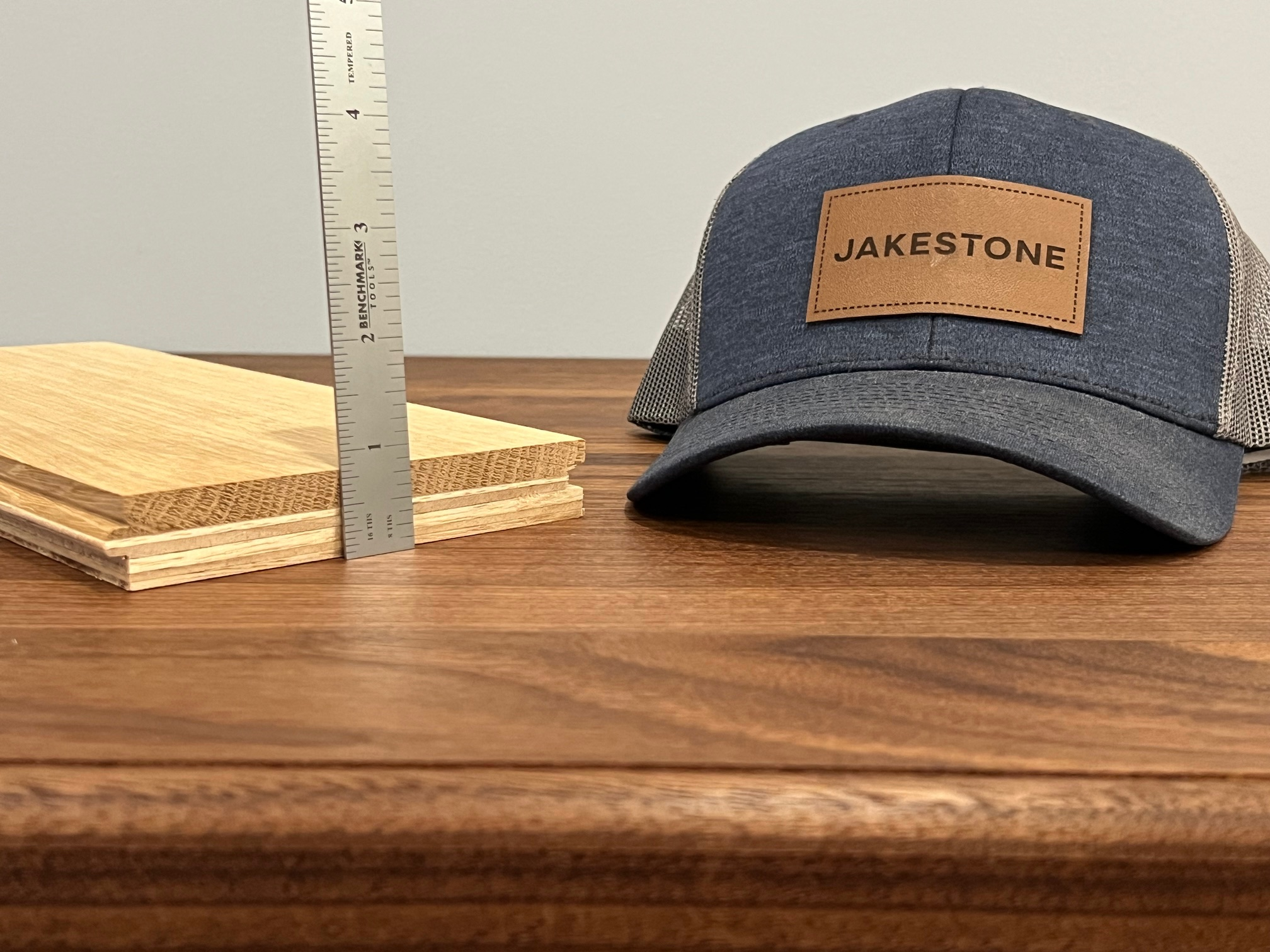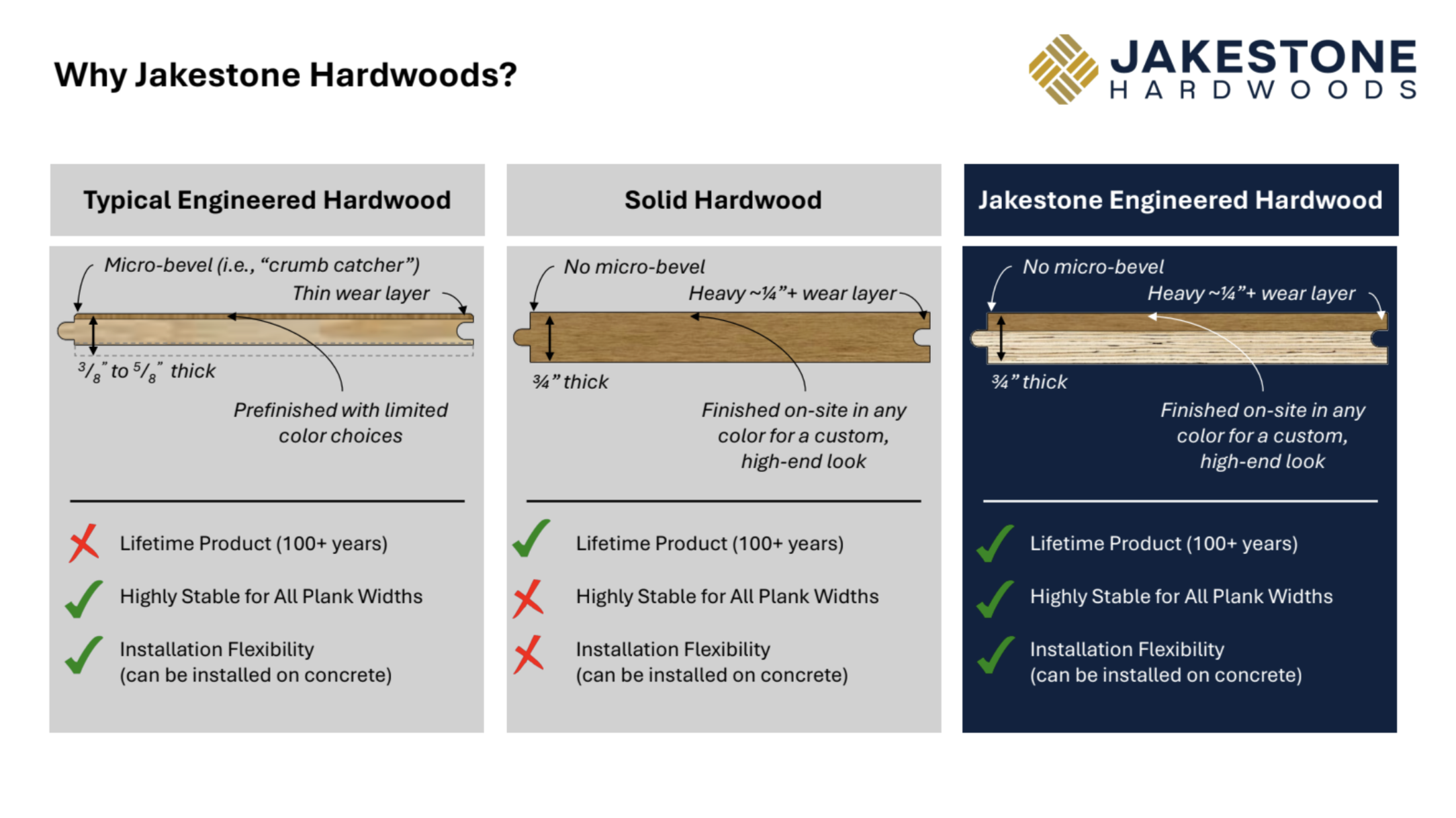How Long Do Engineered Hardwood Floors Last?
At Jakestone Hardwoods, we know our customers care deeply about longevity and value. Engineered hardwood floors are remarkably durable, but their lifespan varies.
Industry experts agree: the lifespan of an engineered hardwood floor comes down to how it’s made. Unfortunately, many low-cost floors on the market are built with ultra-thin veneers, weak plywood cores, and low-quality finishes. These shortcuts often lead to floors wearing out in just 5 years or less, causing frustration, added expense, and the hassle of replacing your flooring far sooner than expected.
At Jakestone, we take a very different approach.
Every Jakestone floor is built with a thick hardwood wear layer—comparable to solid hardwood—and bonded to a premium multi-ply birch core with no voids. On top of that, we apply multiple coats of a high-performance polyurethane finish for long-term surface protection and lasting beauty.
This isn’t just a floor that looks good on day one. It’s engineered for real life.
Jakestone floors can be sanded and refinished multiple times, just like traditional solid hardwood floors. That means they’re designed to grow with your family, stand up to everyday wear, and maintain their beauty for generations—as long as they’re properly cared for and maintained.
When you choose Jakestone, you’re not just buying a hardwood floor—you’re investing in quality that lasts, craftsmanship you can feel, and timeless elegance your family will enjoy for decades to come.
What Determines How Long an Engineered Floor Lasts?
Several key factors influence the durability and longevity of engineered hardwood flooring. At Jakestone, we intentionally optimize each one to ensure our floors provide lasting beauty and performance for generations.
Material Quality
It starts with the core. We use void-free birch plywood for maximum stability and strength—eliminating weak spots that can lead to warping or failure over time. Our hardwood veneers are carefully sourced directly from some of the finest mills in the Southeast, known for consistent quality and craftsmanship. The result is a surface that resists dents, scratches, and everyday wear—while showcasing the natural beauty of real hardwood.
Wear Layer Thickness
The thickness of the hardwood veneer directly impacts how many times a floor can be refinished. While many engineered floors have thin wear layers that limit longevity, Jakestone planks feature a premium wear layer over ¼ inch (~8 mm) thick. This allows our floors to be sanded and refinished multiple times—just like solid hardwood—greatly extending their usable life.
Finish Quality
A strong, durable finish is essential for protecting the wood from daily use. We apply 3 coats of high-performance polyurethane to provide long-lasting resistance to scuffs, scratches, and spills—while enhancing the natural beauty of the wood.
Environmental Stability
Solid hardwood is prone to movement when humidity changes. Jakestone’s engineered boards are different. Our layered construction offers superior stability, making our floors ideal for spaces where solid wood would struggle—like basements, over concrete slabs, or in homes with varying moisture levels.
Foot Traffic & Maintenance
Heavy use can wear down any floor, but proper care goes a long way. Simple practices like sweeping, trimming pet nails, and using felt pads on furniture help prevent damage. With routine maintenance and the ability to refinish, Jakestone floors stay beautiful through decades of daily life.
At Jakestone, we build with purpose—no shortcuts, no compromises.
Every plank is designed to endure. With proper care, your Jakestone floor can serve your family not just for years, but for generations.
Engineered vs. Solid Hardwood: Lifespan Comparison
Engineered vs. Solid Hardwood: What Really Lasts?
Solid hardwood flooring has long been valued for its ability to last a lifetime—or even a century—when properly maintained. It can be sanded and refinished multiple times, allowing homeowners to refresh its appearance over the years.
Typical engineered hardwood floors, on the other hand, often fall short. Many are made with thin wear layers and low-grade cores, limiting their lifespan to just 5–20 years. These floors can’t be refinished more than once—if at all—and often need replacing much sooner than expected.
Jakestone engineered floors change the equation.
We’ve taken everything that’s great about solid hardwood—thick wear layers, the ability to refinish, exceptional longevity—and combined it with the structural stability of high-quality engineered construction. Our planks feature:
A thick, sandable wear layer over ¼" (~8 mm)
A void-free birch plywood core for superior dimensional stability
A premium, site-finish-ready surface protected by multiple coats of high-performance polyurethane
The result? A floor that looks and performs like solid hardwood but with better resistance to moisture, greater installation flexibility, and reduced movement over time.
With proper care, Jakestone floors can last for generations—even a century or more—just like traditional solid hardwood.
You’re not just choosing a floor. You’re investing in the kind of enduring quality that becomes part of the home’s story.
No More “Crumb Catchers”
We eliminate the standard micro-bevel—often called a “crumb catcher”—found on most prefinished flooring. Instead of leaving tiny grooves between planks, our site-finished Jakestone floors have flush, square edges that create a smooth, continuous surface.
As flooring experts often note, site-finished floors not only look cleaner—they are cleaner. The finish is seamlessly rolled across the entire surface, sealing hairline gaps and preventing dirt, dust, and moisture from settling between boards.
Custom Color, Seamless Finish
Most prefinished engineered floors come in a limited range of colors and are coated one plank at a time, leaving visible edges and shallow seams.
Jakestone is different. We finish every floor on-site with multiple coats of high-performance polyurethane, applied after installation. This ensures maximum surface protection and a beautifully unified look. Even better? You get an unlimited range of custom colors, tailored to your space and your vision—far beyond the off-the-shelf options.


